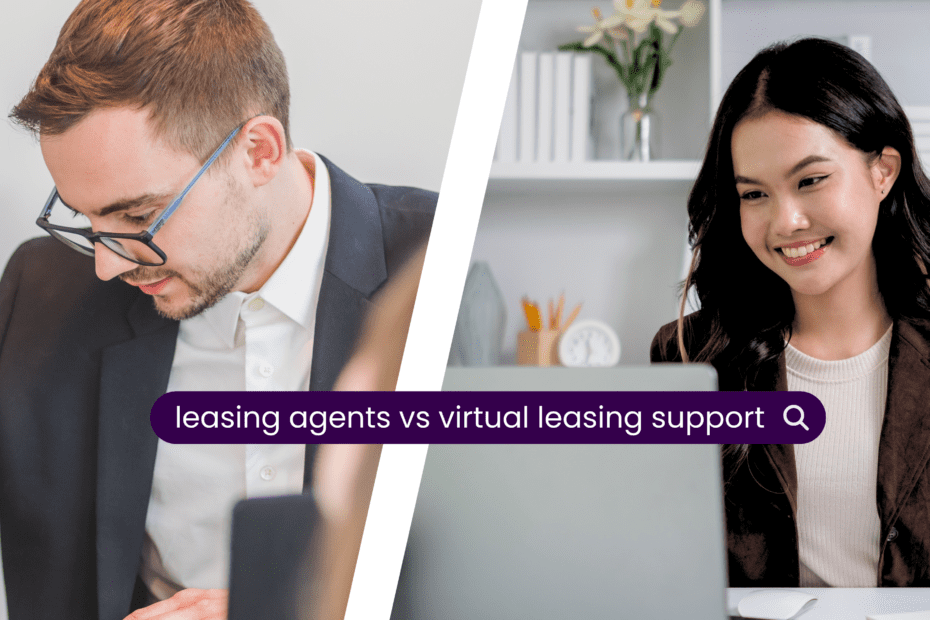Property management companies are under pressure to stay lean, close deals faster, and handle more units with fewer headaches.
So the big question is:
Should you rely on traditional leasing agents—or shift to virtual leasing support?
In this post, we’ll break down the difference, cost, and ROI of both options so you can make the smartest move for your business.
Most of the time, leasing agents are doing both admin and physical tasks.
But you’re overpaying when they spend hours doing email follow-ups or booking tours—stuff a virtual assistant could handle for a fraction of the cost.
What Tasks Can Be Handled by Virtual Leasing Support?
You don’t need a full-time leasing agent just to check emails.
Here’s what a virtual leasing assistant can manage for you:
- Answer rental inquiries via phone, chat, or email
- Schedule showings with prospective tenants
- Send reminders for appointments
- Pre-screen tenants with standard questions
- Draft lease agreements (template-based)
- Follow up with applicants who ghost you
- Update listings on Zillow, RentCafe, etc.
- Maintain CRM tools like AppFolio or Buildium
These tasks eat up hours every week.
Outsourcing them gives your team more time to focus on growth—not busy work.
Want help figuring out what to delegate? Here’s how VA can help you
Cost Comparison: Leasing Agents vs Virtual Leasing Assistants
Let’s talk money.
Leasing Agent Average Salary (US):
- Base: $45,000/year
- Total Cost w/ benefits: $55,000–$65,000+
Virtual Leasing Assistant (through DeleGreat):
- Monthly: $1,200–$1,800
- Annual Cost: $14,400–$21,600
That’s less than half the cost of a full-time leasing agent.
Here’s the breakdown:
With virtual leasing support, you’re not locked into a full-time headcount.
You can scale up or down—without all the HR red tape.
Which Option Offers Better ROI for Property Managers?
ROI = what do you get back for what you spend?
Here’s what we’ve seen from property managers:
- A VA saves 10–20 hours per week in leasing admin
- They handle 100–300 leads/month
- They improve follow-up rates → more leases signed
- You save $30K+/year compared to hiring in-house
Here’s a real-world example:
Client: 350-unit PM company in Texas
- Switched admin leasing tasks to DeleGreat
- Saved $36,000 annually
- Leased 22% more units in the first 3 months
- Leasing agents now only do in-person showings
If your agents are buried in emails and scheduling, you’re bleeding cash.
Let them focus on closing deals—let a virtual assistant handle the rest.
When You Still Need a Physical Leasing Agent
To be clear: virtual leasing assistants don’t replace every function.
Some situations still need a boots-on-the-ground agent:
- In-person showings where local presence is required
- Markets with licensing laws for lease signings
- Luxury properties where clients expect a white-glove service
But that’s a small slice of the pie.
90% of leasing support tasks can be done virtually.
Hybrid Approach: Best of Both Worlds?
What if you don’t want to ditch your leasing agent—but you also don’t want them stuck in admin work all day?
You can combine both.
Here’s how smart property managers do it:
- Keep leasing agents focused on in-person showings and closing deals.
- Hand off all backend admin to a virtual leasing assistant.
For example:

This setup gives you:
- Lower costs
- Faster response times
- Fewer dropped leads
It’s lean. It’s scalable.
And most importantly—it gets results.
Signs You Should Switch to Virtual Leasing Support
Still not sure?
Here are 5 signs it’s time to shift your leasing tasks off your plate:
✅ 1. You’re stuck in email follow-ups.
Inquiries are stacking up and no one’s responding fast enough.
✅ 2. Your agents are doing admin all day.
You’re paying licensed agents to copy/paste into CRMs.
✅ 3. You’re growing but can’t afford another hire.
Virtual support gives you instant capacity—without a full-time salary.
✅ 4. You’re missing calls and losing leads.
A remote assistant can handle phones 7 days a week.
✅ 5. You want to lease faster.
VA support keeps leads hot so more deals close.
If you’re nodding to any of these, it’s time.
How to Start Using Virtual Leasing Support
You don’t need to reinvent the wheel.
Here’s how to get started with zero stress:
1. List your repetitive leasing tasks.
Example: scheduling, follow-ups, CRM work.
2. Choose a provider that knows property management.
👉 DeleGreat trains VAs specifically for leasing tasks.
3. Onboard once—then hand it off.
You’ll get help setting up systems and processes.
Many PMs use Loom videos to record SOPs.
4. Track results.
Measure leads handled, response time, and cost per lease.
In most cases, you’ll see ROI in 30–60 days.
FAQs About Virtual Leasing Support
How is virtual leasing support different from a call center?
Virtual leasing assistants are dedicated team members.
They’re trained in your systems, your SOPs, and your business—not just reading from a script.
Can a virtual assistant legally sign leases?
In most cases, no.
But they can draft lease paperwork for review and help automate the process.
Only licensed professionals should sign where required.
What if I use a leasing CRM like AppFolio or Buildium?
Even better.
Virtual leasing support can manage, update, and organize your CRM daily—so nothing falls through the cracks.
How do I train a virtual leasing assistant?
Use screen recordings (like Loom), or let your provider handle onboarding.
At DeleGreat, VAs come pre-trained in property management tools.
Is virtual leasing support secure and reliable?
Yes, if you’re working with a specialized provider.
At DeleGreat, all VAs go through background checks, NDAs, and secure workstations.
Conclusion: Which One Wins for ROI?
Here’s the truth:
💸 If you want cost-efficiency, speed, and scale → Virtual leasing support wins.
👥 If you need someone on-site for tours → Use a leasing agent.
🚀 If you want the best results → Use both.
Thousands of property management companies are already making the switch.
Why not be one of them?
Check out DeleGreat’s leasing support services and find out how much time—and money—you could save.


